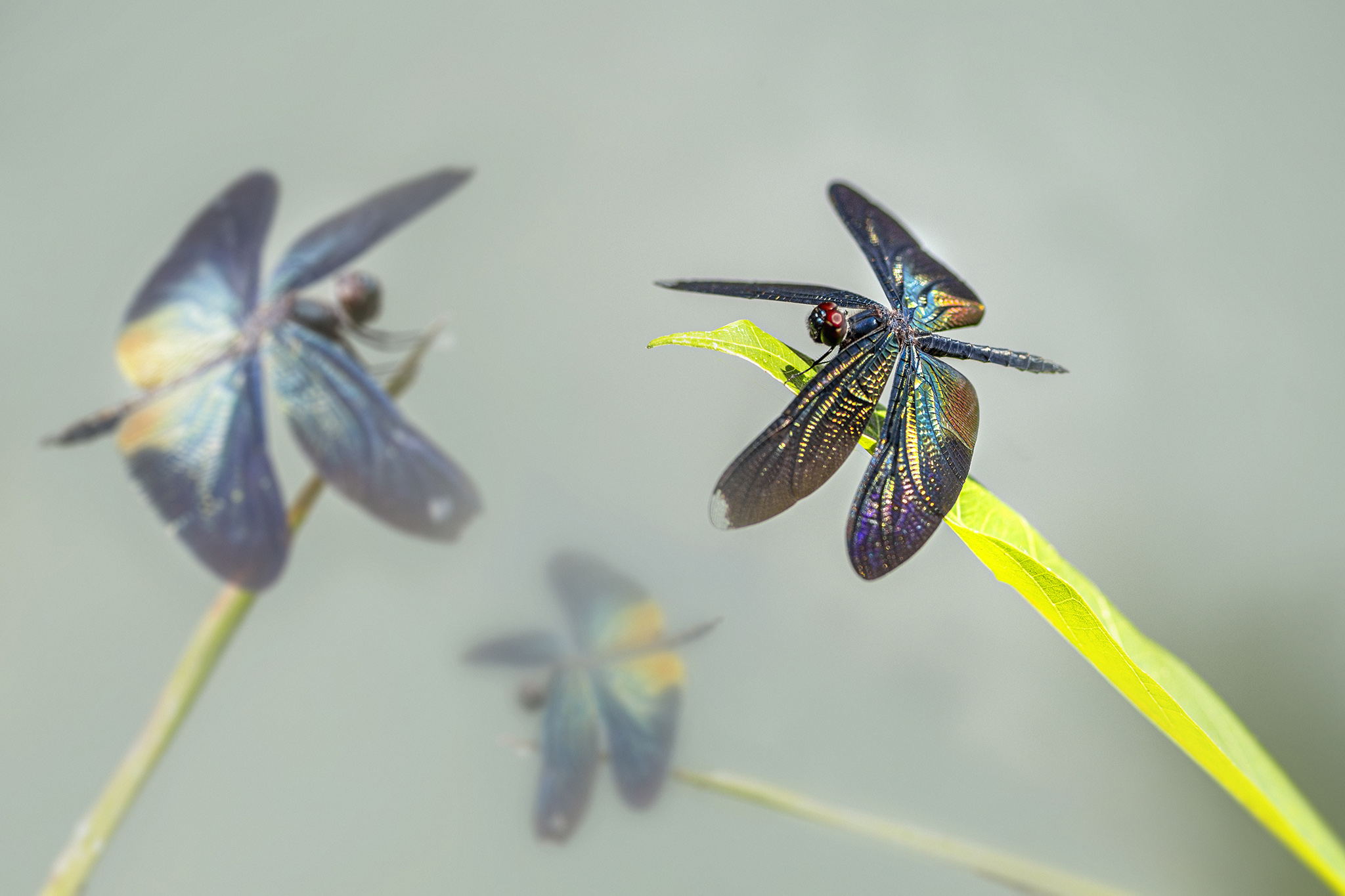Deep Overview: Greater Blue-Wing (Rhyothemis plutonia)
The Greater Blue-Wing (Rhyothemis plutonia) is a medium-sized dragonfly species known for its striking, metallic blue wings that shimmer in sunlight. Belonging to the family Libellulidae (skimmer dragonflies), this species is often seen gliding gracefully over ponds, lakes, and slow-moving rivers in tropical and subtropical regions of Asia. Unlike many dragonflies, the broad, rounded wings of Rhyothemis plutonia give it a butterfly-like flight pattern, making it one of the most visually captivating species in its habitat.
Taxonomy & Classification
- Kingdom: Animalia
- Phylum: Arthropoda
- Class: Insecta
- Order: Odonata (Dragonflies & Damselflies)
- Family: Libellulidae (Skimmers)
- Genus: Rhyothemis
- Species: Rhyothemis plutonia
- Common Name: Greater Blue-Wing
Physical Description
- Size:
- Body length: ~30–40 mm (1.2–1.6 inches)
- Wingspan: ~50–60 mm (2.0–2.4 inches)
- Coloration & Markings:
- Males:
- Brilliant metallic blue wings, which appear almost iridescent in sunlight
- Dark brown to black body, often with a slight metallic sheen
- Females:
- Less vibrant, with duller wing coloration and a more brownish body
- Wings may have a golden or greenish tint instead of bright blue
- Males:
- Key Features:
- Broad, rounded wings, unlike most dragonflies
- Fluttering flight resembling a butterfly
- Wings appear different shades depending on the angle of light
Distribution & Habitat
- Geographic Range:
- Found in South and Southeast Asia, including India, Thailand, Malaysia, Indonesia, and the Philippines
- Also occurs in parts of China and Japan
- Preferred Habitat:
- Inhabits wetlands, lakes, ponds, and slow-moving rivers
- Prefers tropical and subtropical climates with abundant aquatic vegetation
- Often seen perching on reeds or flying low over the water
Behavior & Adaptations
- Flight Pattern:
- Characterized by slow, fluttering movements, resembling butterflies
- Can hover for extended periods before making sudden dashes
- Territoriality:
- Males defend small territories around ponds and lakes, engaging in aerial battles
- Perching Behavior:
- Frequently perches on tall grasses or reeds, scanning for prey
- Thermoregulation:
- Wings shimmer differently depending on the angle of light, which may aid in temperature regulation
Diet & Feeding Habits
- Nymphs (Aquatic Larvae):
- Ambush predators, feeding on mosquito larvae, small fish, and aquatic insects
- Adults:
- Aerial hunters, catching prey mid-flight
- Feed on flies, mosquitoes, midges, and small butterflies
- Feeding Strategy:
- Uses sharp mandibles and strong legs to grab and crush prey mid-air
Reproduction & Life Cycle
- Breeding Season:
- Mostly during the warm months (spring to summer)
- Mating Behavior:
- Males perform aerial displays to attract females
- Mating occurs in the typical “wheel” position seen in dragonflies
- Egg-Laying (Oviposition):
- Females lay eggs in shallow waters, often dipping their abdomens repeatedly on the surface
- Nymph Stage:
- Lives in aquatic environments for several months
- Undergoes multiple molts before emerging as an adult
- Adult Lifespan:
- A few weeks to a couple of months
Predators & Threats
- Natural Predators:
- Birds (kingfishers, swallows, bee-eaters)
- Larger dragonflies
- Fish and amphibians (frogs, newts)
- Human-Related Threats:
- Habitat destruction (deforestation, wetland drainage)
- Pollution of freshwater ecosystems
- Climate change affecting breeding patterns
- Conservation Status:
- Not officially assessed, but populations appear stable
Ecological Importance
- Natural Mosquito Control:
- Both larvae and adults help control mosquito populations
- Bioindicator of Water Quality:
- Thrives in clean, unpolluted freshwater systems
- Prey for Other Wildlife:
- Important food source for birds, fish, and amphibians
Relationship with Humans
- Non-Aggressive & Harmless:
- Unlike some insects, they do not bite or sting humans
- Admired for Their Beauty:
- Frequently photographed due to their brilliant, iridescent wings
- Used in Ecological Studies:
- Helps scientists assess wetland ecosystem health
Similar Species & Identification
- Lesser Blue-Wing (Rhyothemis fuliginosa)
- Smaller, with less intense blue coloration
- Sapphire Flutterer (Rhyothemis resplendens)
- Similar body shape but has a more violet tint in its wings
- Common Flasher (Rhyothemis variegata)
- Wings are more spotted rather than fully colored
Fun Facts
- Its wings appear to change color depending on the angle of sunlight
- It is one of the few dragonflies with a truly “fluttering” flight
- The genus Rhyothemis is known as “Flutterers” due to their unique flight behavior
- Dragonflies existed long before dinosaurs, with ancestors dating back 300 million years
Conclusion
The Greater Blue-Wing is a dazzling, metallic dragonfly that thrives in wetland environments. With its butterfly-like flight, striking blue wings, and role in mosquito control, it remains an important species for freshwater ecosystems. Protecting wetlands and minimizing pollution ensures the survival of this beautiful and ecologically valuable insect.
Views: 1322
Subscribe to the newsletter:
